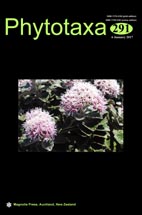Abstract
Fagopyrum longzhoushanense (Polygonaceae) is here described and illustrated as a new species from Longzhoushan (Puge County, Sichuan Province, China) on the basis of morphological, caryological and molecular analyses. The new species is morphologically similar to F. gracilipes from which it differs in having densely pubescent or villose parts, thicker and red-brown stems and branches, dense nodes, rugulose and small postulate leaf blade on the surface, stamens longer than pistils. Another similar species is F. densovillosum from which F. longzhoushanense differs by the winged and greater achenes, and the stamens which are longer than the pistils. From the caryioogical point of view F. longzhoushanense is a diploid species with 2n=2x=16 and a karyotype of 16 metacentric chromosomes, while F. gracilipes is tetraploid, 4n=4x=32, with a karyotype of 30 metacentric and 2 submetacentric chromosomes. The results of molecular marker analysis (matK) also highlight the distinction of the new species.

